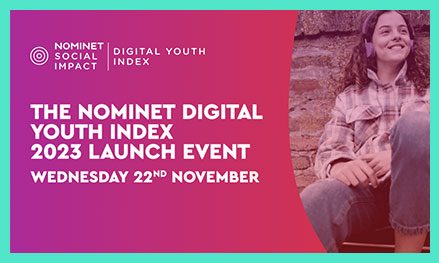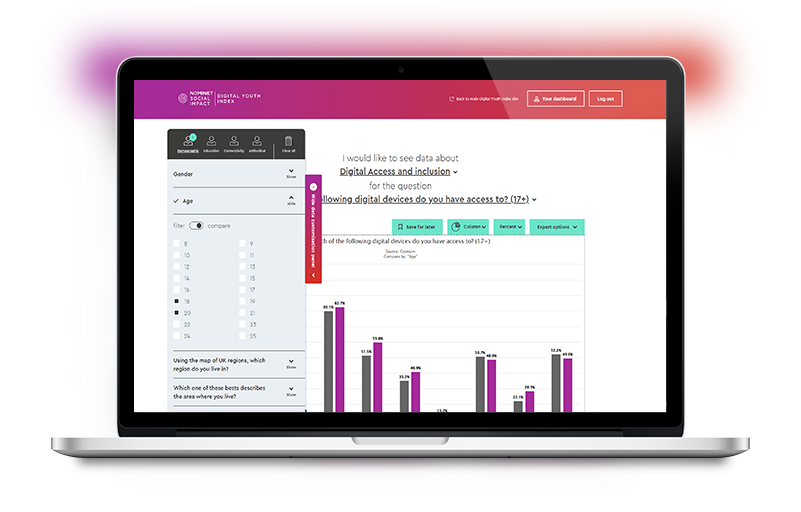Digital connectivity, having the means to access and use the internet through a fast and reliable connection, is an area which impacts young people across different genders, educations, disabilities and living arrangements.
Our data alone shows that there are 1,077 young people with a connectivity index score below 50%, which is 26% of the sample. If we project this onto the UK population, this gives a figure of 3.7 million young people who would benefit from better digital connectivity, and this is likely to be underestimated.
When we start to look at the profiles of those impacted, and the effect of the cost-of-living crisis, our 2022 research highlights some areas which need to be addressed.
Cost-of-living crisis sees internet packages being changed or cancelled
The cost-of-living crisis is showing a clear impact on digital connectivity. When our online survey took place in July 2022 the crisis was just starting to become apparent but despite this, our findings in this area are already stark. Over a fifth (21%) of all respondents to the Digital Youth Index said they are struggling to pay their household bills each month, and 10% have had to change or cancel their internet package.
Coupled with Office for National Statistics data which reports that in response to increases in the cost of living, 69% of adults said they were spending less on non-essentials and 60% said they were using less fuel at home (such as gas and electricity), it becomes clear that having internet access may be considered less essential to some households, or limited access to the internet might become more common.
The cost-of-living crisis has meant that young people from ethnic minority groups are also more likely to have had to change or cancel their internet package (13% vs 10% for white respondents), and we see a similar story for those who not speak English or Welsh as their primary language at home (15% vs 10%).
13% of young people from ethnic minority groups have had to change or cancel internet packages due to the cost-of-living crisis, compared to 10% from non-ethnic minority groups.
Young people living in lower income households and those in care are more likely to have poor digital connectivity
When we look at digital connectivity in relation to household income and living arrangements, there are some clear correlations. Our 2022 data shows that those living in lower income households (up to £20k per year) have a lower connectivity index of 65% compared to those in the upper income tier (over £80k per year) where the connectivity index is 75%.
Similarly, the impact of living arrangements on connectivity is quite clear, with young people who live with a guardian or carer having poorer connectivity (47%) compared to those living with parents (69%) or friends (72%).
Young men/boys have a lower digital connectivity score
There are also some unexpected differences when it comes to gender and digital connectivity. Our 2022 data shows that digital connectivity scores for young men/boys is 66%, while for young women/girls it is 70%, where the higher score here shows the better outcome.
While the data does not tell us why this is the case, an interesting hypothesis could be that there are differences in expectations and needs, and what is perceived to be a good quality device and connection depending on how respondents are using the internet. For example, if there is more propensity for online gaming or technology use among young men/boys, this might require a higher speed of connection and a device with greater processing power.
Young men/boys have a poorer digital connectivity score (66%) compared to young women/ girls (70%).
Interestingly, there are also some unexpected differences when we look at education, with lower scores (62%) of digital connectivity among young people attending independent/private and selective state schools compared to those attending non-selective state schools (68%).
Poor digital connectivity is more predominant among young people from ethnic minorities and those living with disabilities
Poor digital connectivity also seems more predominant for speakers of other languages and ethnic minorities. The digital connectivity score for white respondents was 69% compared to 65% for young people from other ethnic groups. When we look at language, those who primarily speak English or Welsh at home have a higher digital connectivity score of 68% compared to 62% for those who speak another language.
Disability can also be a barrier to digital connectivity for young people. This is most apparent among young people with physical limitations, such as those with impaired dexterity (54%) or mobility issues (59%) when compared to young people without a disability (70%).
Young people living with impaired dexterity have a poorer digital connectivity score (54%) compared to those without a disability (70%).
While being able to access the internet quickly and conveniently is something many of the UK population may take for granted, the above summary of data from the Digital Youth Index regarding digital connectivity shows that this is still an area that needs to be focused on for young people, especially those from lower income households, those with disabilities and those from ethnic minorities. The cost-of-living crisis is certainly having an impact on digital connectivity and is likely to continue to affect more young people over the coming months and year ahead.
While being able to access the internet quickly and conveniently is something many of the UK population may take for granted, the above summary of data from the Digital Youth Index regarding digital connectivity shows that this is still an area that needs to be focused on for young people, especially those from lower income households, those with disabilities and those from ethnic minorities. The cost-of-living crisis is certainly having an impact on digital connectivity and is likely to continue to affect more young people over the coming months and year ahead.
You can look deeper into these findings and explore the data using our data tool for insights around young people’s attitudes, behaviours, perceptions and experiences of growing up online.
Share this article







